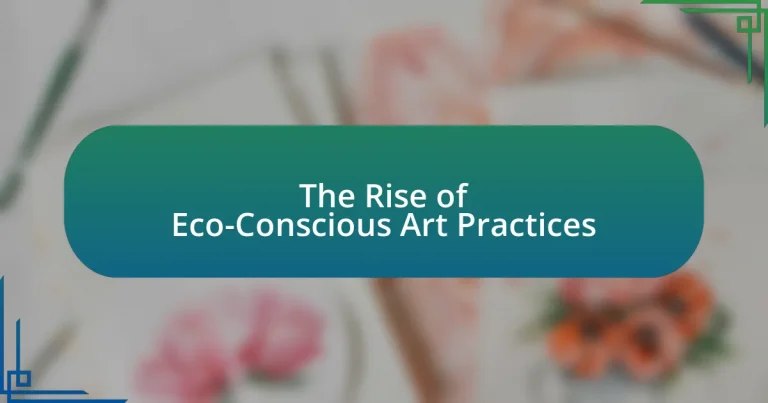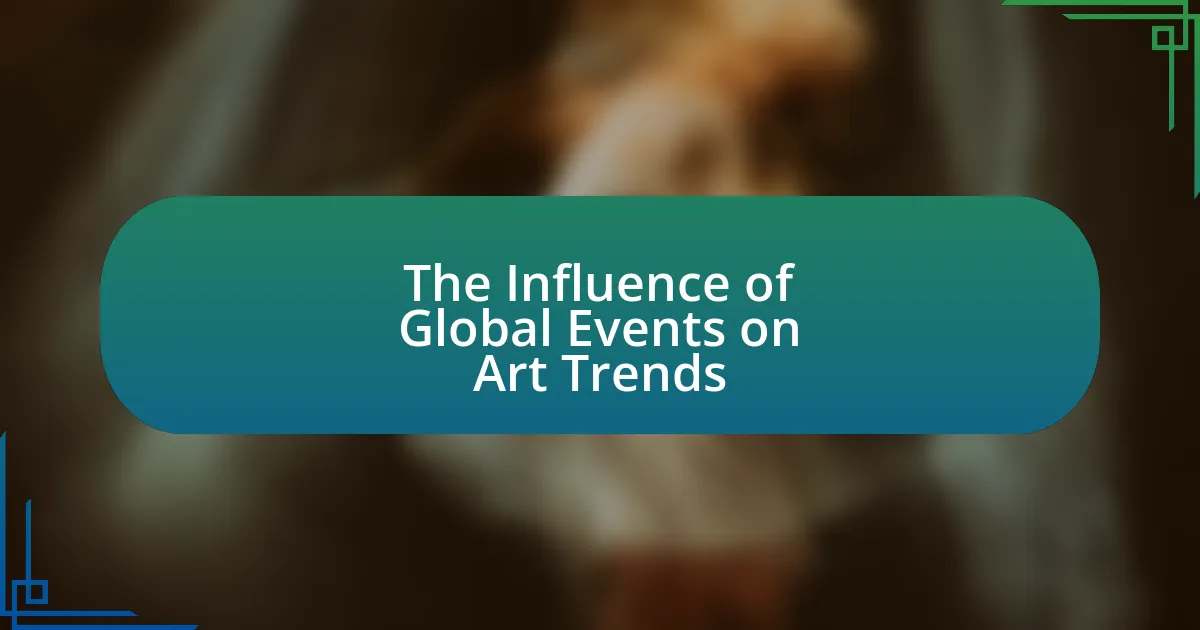Eco-conscious art practices are artistic methods that emphasize environmental sustainability and ecological awareness in their creation and presentation. These practices emerged in response to environmental degradation, gaining momentum in the late 20th century, influenced by significant historical events such as the publication of “Silent Spring” and the first Earth Day. Key figures in this movement include artists like Olafur Eliasson and Maya Lin, who utilize sustainable materials and themes to address critical environmental issues such as climate change and pollution. The article explores the characteristics, challenges, and future of eco-conscious art, highlighting its importance in promoting sustainability and fostering societal change through creative expression.
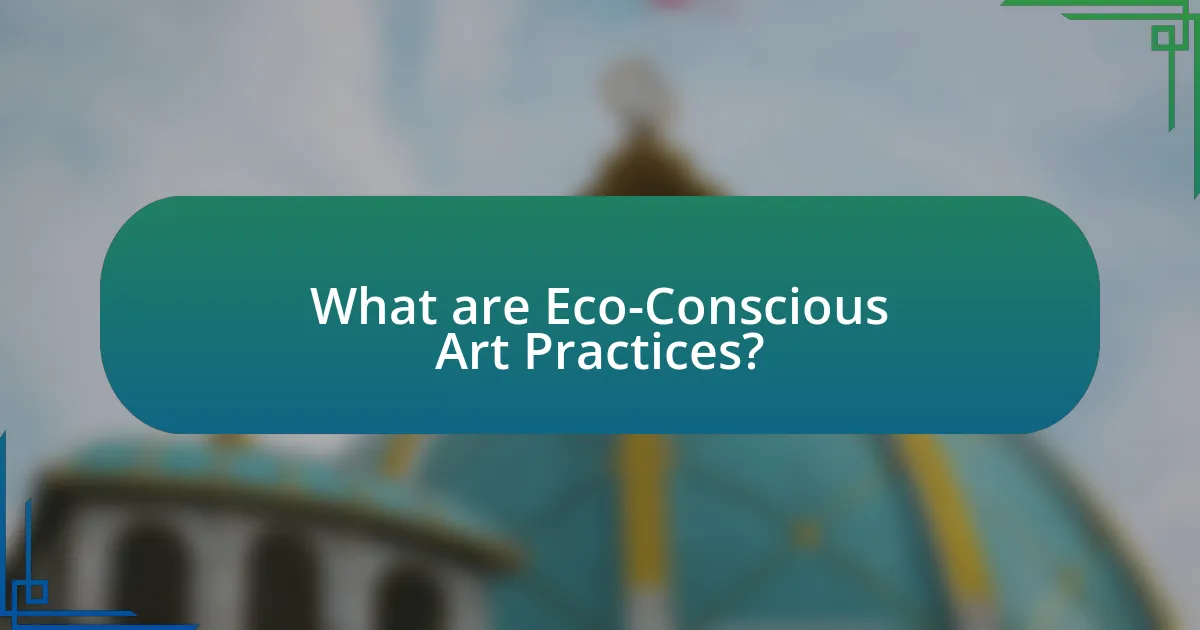
What are Eco-Conscious Art Practices?
Eco-conscious art practices are artistic methods that prioritize environmental sustainability and ecological awareness in their creation and presentation. These practices often involve using recycled materials, non-toxic substances, and sustainable techniques to minimize environmental impact. For instance, artists may utilize natural pigments, repurpose waste materials, or engage in community-based projects that promote ecological education. The rise of eco-conscious art practices reflects a growing recognition of the environmental crisis, with artists aiming to inspire change and raise awareness about ecological issues through their work.
How did Eco-Conscious Art Practices emerge?
Eco-Conscious Art Practices emerged as a response to environmental degradation and climate change, gaining traction in the late 20th century. Artists began to address ecological issues through their work, influenced by movements such as environmentalism and sustainability. The 1960s and 1970s saw a rise in awareness of ecological crises, prompting artists to utilize natural materials and explore themes of nature and conservation. Notable examples include the Land Art movement, where artists like Robert Smithson and Andy Goldsworthy created works that interacted with the landscape, emphasizing the relationship between art and the environment. This shift reflects a broader cultural recognition of the need for sustainable practices in various fields, including art.
What historical events influenced the rise of Eco-Conscious Art Practices?
The rise of Eco-Conscious Art Practices was significantly influenced by the environmental movement of the 1960s and 1970s, particularly events such as the publication of Rachel Carson’s “Silent Spring” in 1962, which raised awareness about pesticide use and its ecological impact. This period also saw the first Earth Day celebrated in 1970, galvanizing public concern for environmental issues and inspiring artists to incorporate ecological themes into their work. Additionally, the establishment of environmental regulations, such as the Clean Air Act of 1970 and the Clean Water Act of 1972, highlighted the need for sustainable practices, further motivating artists to engage with environmental topics. These historical events collectively fostered a cultural shift towards eco-consciousness in art, leading to the emergence of practices that prioritize sustainability and environmental awareness.
Who are the key figures in the development of Eco-Conscious Art Practices?
Key figures in the development of Eco-Conscious Art Practices include artists such as Agnes Meyer-Brandis, who is known for her work in eco-art and environmental activism, and Olafur Eliasson, recognized for his installations that engage with climate change and nature. Additionally, artists like Chris Jordan, who creates large-scale works that address consumerism and waste, and Maya Lin, who integrates environmental themes into her architectural and artistic projects, have significantly contributed to this movement. Their works often reflect a commitment to sustainability and raise awareness about ecological issues, thereby influencing the broader discourse on art and the environment.
Why are Eco-Conscious Art Practices important today?
Eco-conscious art practices are important today because they address environmental issues and promote sustainability through creative expression. These practices raise awareness about climate change, pollution, and biodiversity loss, encouraging both artists and audiences to engage in ecological conversations. For instance, a study by the United Nations Educational, Scientific and Cultural Organization (UNESCO) highlights that art can effectively communicate complex environmental messages, making them more accessible to the public. Additionally, eco-conscious art often utilizes sustainable materials and methods, reducing the carbon footprint associated with traditional art production. This shift not only fosters a culture of environmental responsibility but also inspires collective action towards a more sustainable future.
What environmental issues do Eco-Conscious Art Practices address?
Eco-Conscious Art Practices address several critical environmental issues, including climate change, pollution, biodiversity loss, and resource depletion. These practices aim to raise awareness about the impact of human activities on the environment and promote sustainability through the use of recycled materials, eco-friendly processes, and themes that highlight ecological concerns. For instance, artists often utilize waste materials to create their works, thereby reducing landfill contributions and encouraging recycling. Additionally, studies show that art can effectively communicate complex environmental issues, making them more accessible to the public and inspiring action towards conservation efforts.
How do these practices impact the art community and society?
Eco-conscious art practices significantly impact the art community and society by promoting sustainability and environmental awareness. These practices encourage artists to use recycled materials and eco-friendly methods, which not only reduce waste but also inspire audiences to consider their own environmental footprints. For instance, exhibitions featuring eco-conscious art often attract attention to climate change issues, fostering dialogue and community engagement around sustainability. Research from the Journal of Environmental Psychology indicates that exposure to eco-art can enhance pro-environmental behaviors among viewers, demonstrating a direct correlation between art and societal change.
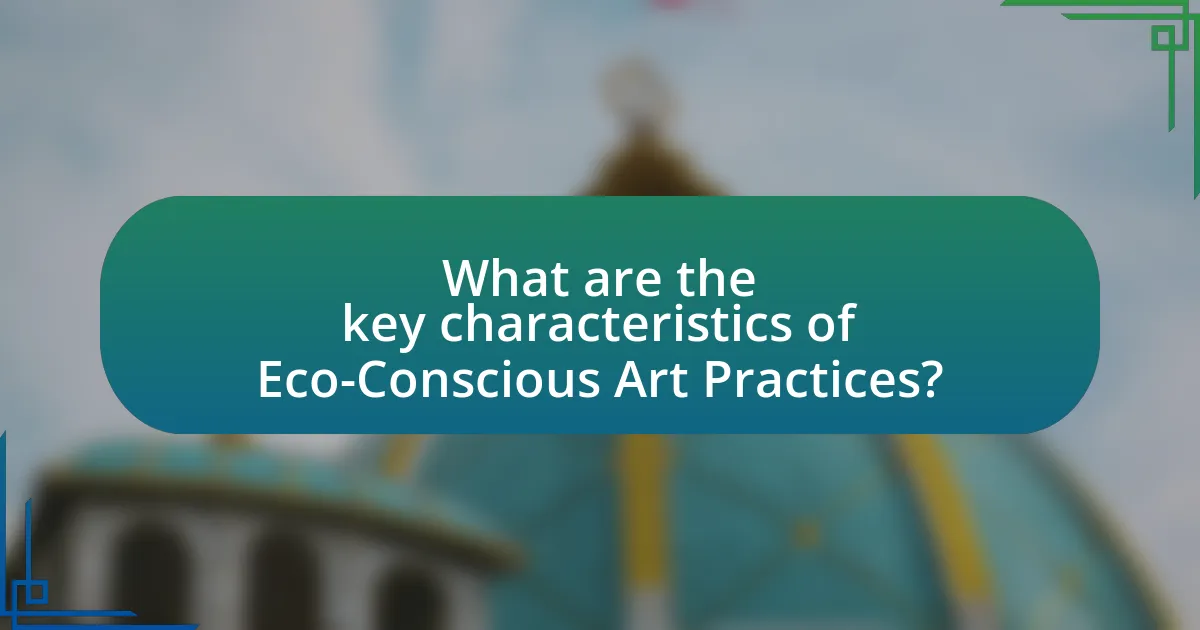
What are the key characteristics of Eco-Conscious Art Practices?
Eco-conscious art practices are characterized by their commitment to sustainability, environmental awareness, and the use of eco-friendly materials. These practices prioritize reducing waste and minimizing environmental impact, often incorporating recycled or natural materials in the creation of artworks. For instance, artists may utilize biodegradable substances or repurpose found objects, reflecting a deep respect for nature and a desire to raise awareness about ecological issues. Additionally, eco-conscious art often engages with themes of climate change, biodiversity, and conservation, aiming to inspire viewers to consider their relationship with the environment. This approach not only fosters a dialogue about ecological responsibility but also promotes a shift towards more sustainable practices within the art community.
What materials are commonly used in Eco-Conscious Art Practices?
Eco-conscious art practices commonly utilize sustainable materials such as recycled paper, natural pigments, organic fabrics, and biodegradable plastics. These materials are chosen for their minimal environmental impact and ability to reduce waste. For instance, recycled paper is made from post-consumer waste, significantly lowering the demand for virgin resources. Natural pigments, derived from plants and minerals, avoid harmful chemicals found in synthetic dyes. Organic fabrics, such as cotton or hemp, are cultivated without synthetic pesticides, promoting healthier ecosystems. Biodegradable plastics, made from renewable resources, decompose more easily than traditional plastics, reducing long-term pollution.
How do artists select sustainable materials for their work?
Artists select sustainable materials for their work by evaluating the environmental impact, sourcing practices, and lifecycle of the materials. They often prioritize renewable resources, recycled content, and non-toxic substances to minimize ecological harm. For instance, many artists choose organic paints, reclaimed wood, or biodegradable materials, which have a lower carbon footprint compared to conventional options. Research indicates that the use of sustainable materials can significantly reduce waste and pollution, aligning with eco-conscious art practices that aim to promote environmental awareness and responsibility.
What role does recycling play in Eco-Conscious Art Practices?
Recycling plays a crucial role in eco-conscious art practices by providing artists with sustainable materials that reduce waste and environmental impact. By utilizing discarded items, artists not only create unique works but also promote awareness of environmental issues and the importance of sustainability. For instance, the use of recycled materials in art can significantly lower the carbon footprint associated with traditional art supplies, as evidenced by studies showing that up to 70% of an artist’s environmental impact can stem from material sourcing. This practice encourages a circular economy, where materials are reused and repurposed, fostering a culture of sustainability within the art community.
How do Eco-Conscious Art Practices influence artistic expression?
Eco-conscious art practices significantly influence artistic expression by prioritizing sustainability and environmental awareness in the creative process. Artists adopting these practices often utilize recycled materials, natural pigments, and eco-friendly techniques, which not only reduce waste but also inspire innovative approaches to traditional art forms. For instance, the use of biodegradable materials encourages artists to rethink their medium and message, fostering a deeper connection between the artwork and ecological themes. This shift is evident in movements such as Land Art and Eco-Art, where the environment becomes both the canvas and the subject, prompting viewers to engage with pressing environmental issues. The integration of these practices into artistic expression reflects a growing societal emphasis on sustainability, as seen in the increasing number of exhibitions dedicated to eco-conscious themes, such as the “Eco-Visionaries” exhibition at the Royal Academy of Arts in London.
What themes are prevalent in Eco-Conscious Art?
Prevalent themes in Eco-Conscious Art include environmental sustainability, climate change awareness, and the critique of consumerism. These themes reflect artists’ intentions to raise awareness about ecological issues and promote a deeper connection between humanity and nature. For instance, many eco-conscious artworks utilize recycled materials or natural elements to emphasize the importance of sustainability, while others depict the impacts of climate change to provoke thought and inspire action. This thematic focus aligns with a growing movement in contemporary art that seeks to address urgent environmental challenges through creative expression.
How do artists convey messages about sustainability through their work?
Artists convey messages about sustainability through their work by utilizing materials, themes, and practices that highlight environmental issues. For instance, many artists incorporate recycled materials into their creations, which not only reduces waste but also serves as a commentary on consumerism and resource depletion. Additionally, artists often address themes such as climate change, biodiversity loss, and pollution, using visual storytelling to evoke emotional responses and raise awareness. A notable example is the work of Olafur Eliasson, whose installations often engage with natural phenomena and encourage viewers to reflect on their relationship with the environment. This approach is supported by research indicating that art can effectively influence public perception and behavior regarding sustainability, as seen in studies published in the journal “Environmental Communication.”
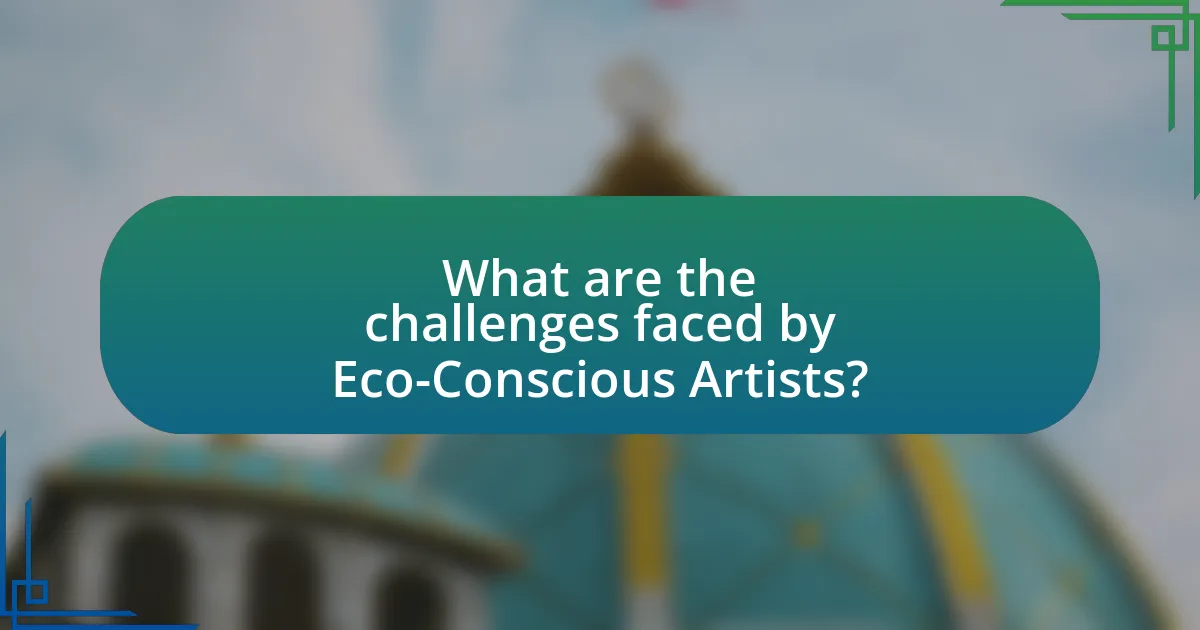
What are the challenges faced by Eco-Conscious Artists?
Eco-conscious artists face several challenges, including limited access to sustainable materials, higher costs associated with eco-friendly practices, and a lack of audience awareness regarding environmental issues. The scarcity of sustainable materials can hinder their ability to create art that aligns with their values, as many traditional art supplies are not environmentally friendly. Additionally, the financial burden of sourcing eco-friendly materials often leads to increased production costs, making it difficult for these artists to compete in a market that may prioritize lower prices over sustainability. Furthermore, many potential viewers may not fully understand or appreciate the significance of eco-conscious art, which can limit the artists’ reach and impact.
What obstacles do artists encounter when adopting Eco-Conscious practices?
Artists encounter several obstacles when adopting eco-conscious practices, primarily including financial constraints, limited access to sustainable materials, and a lack of awareness or education about eco-friendly methods. Financial constraints often arise because sustainable materials and processes can be more expensive than traditional options, making it difficult for artists to justify the costs. Limited access to sustainable materials can hinder artists’ ability to create, especially in regions where such resources are not readily available. Additionally, a lack of awareness or education about eco-friendly practices can prevent artists from implementing sustainable methods effectively, as they may not know how to source materials or techniques that align with eco-conscious principles.
How does funding affect Eco-Conscious Art initiatives?
Funding significantly impacts Eco-Conscious Art initiatives by providing the necessary resources for artists to create sustainable works and engage in environmentally focused projects. Financial support enables artists to access eco-friendly materials, invest in innovative technologies, and implement large-scale installations that promote environmental awareness. For instance, a study by the National Endowment for the Arts found that funded projects often lead to increased community engagement and awareness around ecological issues, demonstrating that adequate funding can enhance the reach and effectiveness of eco-conscious art.
What are the limitations of using sustainable materials in art?
The limitations of using sustainable materials in art include higher costs, limited availability, and potential compromises in aesthetic quality. Sustainable materials often require more resources to produce, leading to increased expenses for artists. Additionally, these materials may not be as widely available as traditional options, restricting artists’ choices. Furthermore, some sustainable materials may not offer the same visual or tactile qualities as conventional materials, which can affect the overall impact of the artwork. For instance, natural pigments can be less vibrant than synthetic ones, influencing the artist’s ability to achieve desired effects.
How can Eco-Conscious Artists overcome these challenges?
Eco-conscious artists can overcome challenges by adopting sustainable materials and practices in their work. By utilizing recycled or biodegradable materials, artists reduce their environmental impact while maintaining artistic integrity. For instance, a study published in the Journal of Cleaner Production highlights that using sustainable materials can significantly lower carbon footprints in art production. Additionally, eco-conscious artists can collaborate with environmental organizations to raise awareness and gain support, thereby amplifying their message and reach. Engaging in community-based projects can also foster a supportive network, enabling artists to share resources and ideas, which further enhances their ability to navigate challenges effectively.
What strategies can artists employ to secure funding for Eco-Conscious projects?
Artists can secure funding for Eco-Conscious projects by applying for grants specifically aimed at environmental initiatives, collaborating with eco-focused organizations, and utilizing crowdfunding platforms. Grants from institutions like the National Endowment for the Arts or private foundations often prioritize projects that promote sustainability, providing financial support for artists committed to eco-conscious practices. Collaborating with organizations such as environmental NGOs can also lead to sponsorship opportunities, as these groups may seek to fund artistic endeavors that align with their missions. Additionally, crowdfunding platforms like Kickstarter or Indiegogo allow artists to present their projects directly to the public, enabling them to raise funds from individuals who are passionate about environmental issues. These strategies are effective as they connect artists with resources and communities that value sustainability, thereby increasing the likelihood of securing necessary funding.
How can collaboration enhance Eco-Conscious Art Practices?
Collaboration can enhance eco-conscious art practices by pooling diverse skills and perspectives, leading to innovative solutions for environmental challenges. When artists collaborate, they can share resources, such as sustainable materials and techniques, which reduces waste and promotes eco-friendly methods. For instance, projects like the “EcoArt Project” demonstrate how artists from various disciplines work together to create installations that raise awareness about ecological issues, effectively engaging communities and fostering a collective responsibility towards the environment. This collaborative approach not only amplifies the impact of individual artworks but also encourages a broader dialogue about sustainability in the art world.

What is the future of Eco-Conscious Art Practices?
The future of eco-conscious art practices is poised for significant growth and innovation as artists increasingly prioritize sustainability and environmental awareness in their work. This shift is driven by a rising global consciousness regarding climate change and ecological degradation, prompting artists to explore materials and methods that minimize environmental impact. For instance, the use of recycled materials and natural pigments is becoming more prevalent, reflecting a commitment to reducing waste and promoting ecological balance. Additionally, initiatives like the “Green Art” movement, which encourages artists to engage with environmental issues, are gaining traction, further embedding eco-consciousness into the art community. As a result, eco-conscious art practices are expected to evolve into a mainstream approach, influencing not only artistic expression but also public discourse on sustainability.
How are technological advancements shaping Eco-Conscious Art?
Technological advancements are significantly shaping Eco-Conscious Art by enabling artists to utilize sustainable materials and innovative techniques that minimize environmental impact. For instance, the development of biodegradable materials and digital fabrication technologies allows artists to create works that are both environmentally friendly and aesthetically compelling. Additionally, advancements in digital art and virtual reality provide platforms for artists to convey eco-conscious messages without the need for physical materials, thus reducing waste. Research indicates that the use of technology in art can lead to a 30% reduction in resource consumption compared to traditional methods, highlighting the effectiveness of these advancements in promoting sustainability within the art community.
What role does digital art play in promoting sustainability?
Digital art plays a significant role in promoting sustainability by providing a platform for environmental awareness and advocacy. Through visual storytelling, digital artists can effectively communicate urgent ecological issues, such as climate change and biodiversity loss, reaching a global audience with minimal resource consumption. For instance, projects like “The Ocean Agency” utilize digital art to highlight coral reef degradation, engaging viewers and inspiring action. Additionally, digital art reduces the need for physical materials, thereby minimizing waste and carbon footprints associated with traditional art forms. This shift towards digital mediums aligns with sustainable practices, as evidenced by the increasing number of artists and organizations adopting eco-conscious approaches in their work.
How can virtual exhibitions support Eco-Conscious Art initiatives?
Virtual exhibitions can significantly support Eco-Conscious Art initiatives by reducing the carbon footprint associated with traditional art displays. By eliminating the need for physical transportation of artworks and the energy consumption of large venues, virtual exhibitions minimize environmental impact. For instance, a study by the International Council of Museums found that digital exhibitions can reduce greenhouse gas emissions by up to 90% compared to in-person events. Additionally, virtual platforms allow artists to reach a global audience without the resource-intensive logistics of travel and shipping, further promoting sustainable practices within the art community.
What can individuals do to support Eco-Conscious Art Practices?
Individuals can support eco-conscious art practices by choosing sustainable materials and promoting environmentally friendly techniques in their artwork. By selecting non-toxic paints, recycled materials, and biodegradable supplies, artists can minimize their ecological footprint. Additionally, individuals can advocate for and participate in community art projects that focus on environmental themes, thereby raising awareness about sustainability. Research indicates that art can effectively communicate ecological issues, making it a powerful tool for advocacy. For instance, a study published in the Journal of Environmental Psychology highlights how art can influence public perception and behavior regarding environmental conservation.
How can art enthusiasts promote Eco-Conscious artists?
Art enthusiasts can promote Eco-Conscious artists by actively sharing their work through social media platforms and art communities. By utilizing platforms like Instagram, Facebook, and Pinterest, art enthusiasts can showcase the sustainable practices and messages behind the artists’ creations, reaching a wider audience. Additionally, organizing or participating in local art events, exhibitions, or eco-focused art fairs can provide Eco-Conscious artists with visibility and networking opportunities. Research indicates that social media engagement can significantly increase an artist’s reach, with a 2019 study showing that artists who actively promote their work online see a 30% increase in audience engagement.
What are some practical tips for engaging with Eco-Conscious Art?
To engage with Eco-Conscious Art, individuals should prioritize visiting galleries and exhibitions that showcase sustainable art practices, as this supports artists committed to environmental themes. Participating in workshops focused on eco-friendly materials and techniques enhances understanding of the medium and its impact. Additionally, following artists and organizations dedicated to eco-conscious art on social media fosters community and awareness of ongoing projects. Research indicates that engaging with art that addresses environmental issues can increase public awareness and inspire action, as seen in initiatives like the “Art for the Earth” campaign, which highlights the role of art in environmental advocacy.
